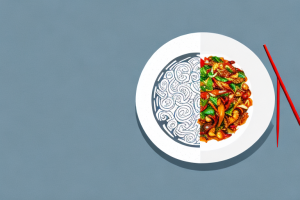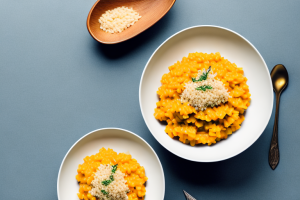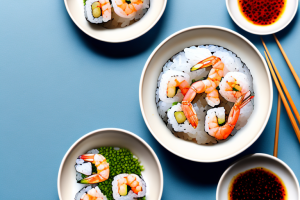How to prepare quinoa rice with corn and black bean salsa
8 min read
A bowl of quinoa rice with corn and black bean salsa
If you’re looking for a healthier alternative to traditional rice dishes, quinoa rice with corn and black bean salsa is a delicious and nutritious option. This dish is packed with protein and fiber from the quinoa and black beans, and the corn adds a sweet crunch that complements the other flavors. Here’s everything you need to know to prepare this dish to perfection.
Why quinoa rice is a healthier alternative to traditional rice
Although rice is a staple ingredient in many cuisines, it’s important to note that not all types of rice are created equal. While white rice is a refined grain that has been stripped of its nutrients, quinoa rice is a whole grain that is rich in fiber, protein, and essential vitamins and minerals. Quinoa also has a low glycemic index, which means it won’t cause blood sugar spikes like white rice can. This makes it a great choice for anyone looking to improve their health and wellbeing.
The nutritional benefits of black beans
Black beans are a versatile and nutritious ingredient that are a great source of plant-based protein. They are also high in fiber, which can help to lower cholesterol levels, improve digestion, and regulate blood sugar levels. Additionally, black beans contain a variety of vitamins and minerals, such as iron, magnesium, and potassium. These nutrients are essential for maintaining a healthy body and preventing chronic diseases.
Furthermore, black beans are a low-fat and low-calorie food, making them an excellent choice for those who are trying to lose weight or maintain a healthy weight. They are also a good source of antioxidants, which can help to protect the body against damage from free radicals and reduce the risk of certain types of cancer.
Black beans are also easy to incorporate into a variety of dishes, such as salads, soups, and stews. They can be used as a meat substitute in vegetarian and vegan recipes, and they are a popular ingredient in Latin American cuisine. Whether you are looking to improve your overall health or simply add some variety to your diet, black beans are a delicious and nutritious choice.
How to cook perfect quinoa every time
Cooking quinoa is simple once you know the basics. Start by rinsing the quinoa in a fine mesh strainer to remove the bitter coating. Then, add it to a pot with the appropriate amount of water or broth (typically a 2:1 ratio of liquid to quinoa). Bring the mixture to a boil, reduce the heat to low, and let it simmer for 15-20 minutes, or until all of the liquid has been absorbed. Fluff the quinoa with a fork and you’re ready to go!
One important thing to note is that quinoa can also be cooked in a rice cooker or pressure cooker for even easier preparation. Additionally, you can add various seasonings and spices to the cooking liquid to give the quinoa extra flavor. Some popular options include garlic, onion, cumin, and chili powder. Experiment with different combinations to find your favorite!
The history and origins of quinoa
Quinoa has been a staple food in South America for thousands of years, dating back to the Inca civilization. Today, it’s widely grown and consumed around the world due to its nutritional value and versatility in cooking. Although technically a seed, quinoa is often referred to as a grain due to its similar appearance and culinary uses.
Quinoa is a highly nutritious food, containing all nine essential amino acids, making it a complete protein source. It’s also high in fiber, iron, and magnesium, making it a popular choice for vegetarians and vegans. In recent years, quinoa has gained popularity as a gluten-free alternative to grains like wheat and barley.
Despite its popularity, the increased demand for quinoa has led to concerns about its sustainability and impact on the environment. The majority of quinoa is grown in Bolivia and Peru, where it’s an important crop for local farmers. However, the rise in demand has led to increased prices, making it less affordable for locals. Additionally, the increased production has led to environmental concerns, such as soil erosion and water depletion.
The versatility of corn in different cuisines
Corn is a staple food in many cultures around the world, from Mexico to Asia to Africa. It can be used in a variety of dishes, from stews to salads to desserts. Corn is also a good source of dietary fiber and contains several vitamins and minerals, such as vitamin C and phosphorous.
In Mexican cuisine, corn is a key ingredient in dishes such as tacos, tamales, and tortillas. In Asian cuisine, corn is often used in soups and stir-fries. In African cuisine, cornmeal is used to make porridge and bread. Corn is also a popular ingredient in many American dishes, such as cornbread and popcorn. With its versatility and nutritional benefits, it’s no wonder that corn has become a staple food in so many cultures around the world.
Different methods for cooking corn
There are several methods for cooking corn, including boiling, grilling, and roasting. To boil corn, simply bring a pot of water to a boil, add the corn, and cook for 5-7 minutes. To grill corn, brush the ears with oil, wrap them in foil, and grill over medium heat for 10-15 minutes, turning occasionally. Roasting corn involves placing the shucked ears directly on the oven rack and baking at 350°F for 20-25 minutes.
Another method for cooking corn is to steam it. To steam corn, place the shucked ears in a steamer basket over boiling water and cook for 5-7 minutes. This method helps to retain the nutrients and natural sweetness of the corn.
For a unique twist on traditional corn on the cob, try making elote, a Mexican street food. To make elote, grill or roast the corn, then slather it with a mixture of mayonnaise, chili powder, lime juice, and cotija cheese. This flavorful dish is sure to be a hit at your next barbecue or summer gathering.
Tips for selecting and storing black beans
When selecting black beans, look for those that are dry, firm, and without cracks. Avoid beans that are discolored or have an unusual odor. To store black beans, keep them in an airtight container in a cool, dry place. Cooked black beans can be stored in the refrigerator for up to five days or in the freezer for up to three months.
Black beans are a great source of protein, fiber, and other essential nutrients. They are also low in fat and calories, making them a healthy addition to any diet. To get the most nutritional value from black beans, it is recommended to soak them overnight before cooking. This helps to reduce the cooking time and also makes them easier to digest.
Black beans can be used in a variety of dishes, including soups, stews, salads, and even desserts. They are a versatile ingredient that can be seasoned with a variety of spices and herbs to create different flavors. Some popular seasonings for black beans include cumin, chili powder, garlic, and onion.
Creative ways to add protein to your diet through quinoa and black beans
Quinoa and black beans are both excellent sources of protein that can be incorporated into a variety of dishes. Mix them with roasted vegetables for a flavorful and satisfying bowl, or add them to a green salad for a protein-packed lunch. You can also use quinoa and black beans in place of meat in dishes like tacos, burritos, and stir-fries.
Another great way to incorporate quinoa and black beans into your diet is by making a hearty soup. Combine them with vegetables, broth, and spices for a filling and nutritious meal. You can also use quinoa and black beans to make veggie burgers or meatballs, which are a delicious and healthy alternative to traditional meat-based options.
Aside from being a great source of protein, quinoa and black beans also offer a range of other health benefits. Quinoa is high in fiber, iron, and magnesium, while black beans are packed with antioxidants and vitamins. By incorporating these ingredients into your meals, you can improve your overall health and wellbeing.
How to customize the salsa recipe with different ingredients
The beauty of this salsa recipe is that it’s highly customizable. Feel free to add additional vegetables like diced tomatoes, red onion, or bell peppers. You can also adjust the seasonings to suit your taste preferences, adding more cumin, chili powder, or lime juice as desired.
If you want to make your salsa recipe even more unique, try experimenting with different types of peppers. You can use jalapeños for a spicier kick, or poblano peppers for a milder flavor. Another option is to add fruits like mango or pineapple for a sweet and tangy twist. Don’t be afraid to get creative and make the recipe your own!
Vegan and gluten-free options for this recipe
This recipe is naturally vegan and gluten-free, making it a great option for those with dietary restrictions. Just be sure to check the labels of any packaged ingredients (like canned corn or black beans) to ensure they are also vegan and gluten-free.
If you want to add some extra protein to this recipe, you can try adding some tofu or tempeh. Both are vegan and gluten-free, and can be a great addition to this dish.
Another option to consider is using quinoa instead of rice. Quinoa is a gluten-free grain that is also high in protein, making it a great alternative to rice. Plus, it adds a nice texture and flavor to the dish.
Serving suggestions and pairing options for the dish
This quinoa rice with corn and black bean salsa is a complete meal on its own, but it can also be paired with other dishes for a more complete spread. Serve it with tortilla chips for a fun and festive appetizer, or pair it with grilled chicken or fish for a more substantial meal.
A step-by-step guide to preparing the salsa from scratch
To make the salsa from scratch, start by mixing together 1 can of drained and rinsed black beans, 1 can of drained corn, 1 diced jalapeño pepper (remove seeds if you prefer less heat), 1 diced red bell pepper, and 1/4 cup chopped fresh cilantro in a large bowl. In a separate small bowl, whisk together 1/4 cup olive oil, the juice of 1 lime, 1 teaspoon cumin, 1/2 teaspoon chili powder, and salt and pepper to taste. Pour the dressing over the salsa and stir to combine. Serve immediately or refrigerate until ready to eat.
What makes this dish ideal for meal prep and leftovers
This quinoa rice with corn and black bean salsa is an excellent choice for meal prep and leftovers. The components can be prepared ahead of time and stored separately in the fridge, then combined just before serving. Leftover portions can be packed for lunches or reheated for a quick and easy dinner.
How to make a healthy, flavorful dressing to complement the dish
The dressing for this salsa is simple to make and adds a bright, tangy flavor that complements the other ingredients. In a small bowl, whisk together 1/4 cup olive oil, the juice of 1 lime, 1 teaspoon cumin, 1/2 teaspoon chili powder, and salt and pepper to taste. Adjust the seasonings as needed and pour over the salsa just before serving.
Now that you have all the information you need, it’s time to get cooking! With its delicious flavors and healthful ingredients, this quinoa rice with corn and black bean salsa is sure to become a new favorite in your recipe rotation. Bon appétit!


